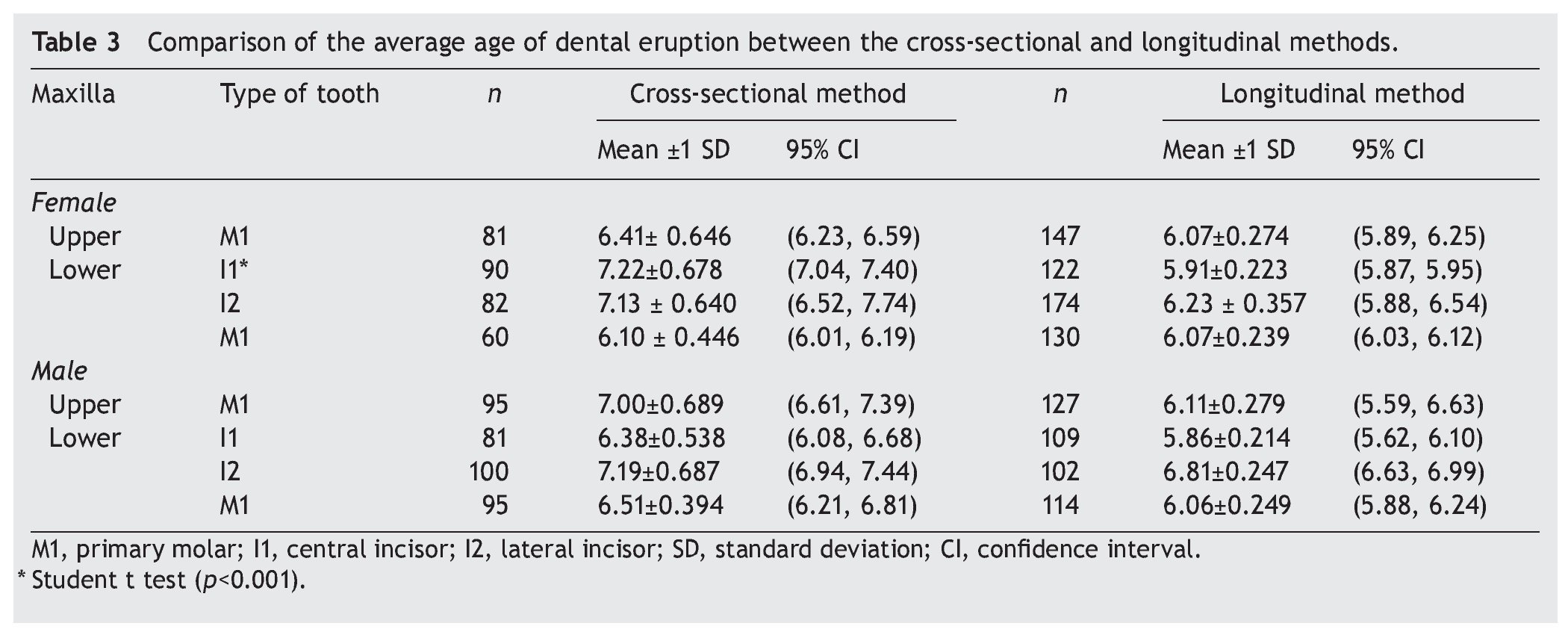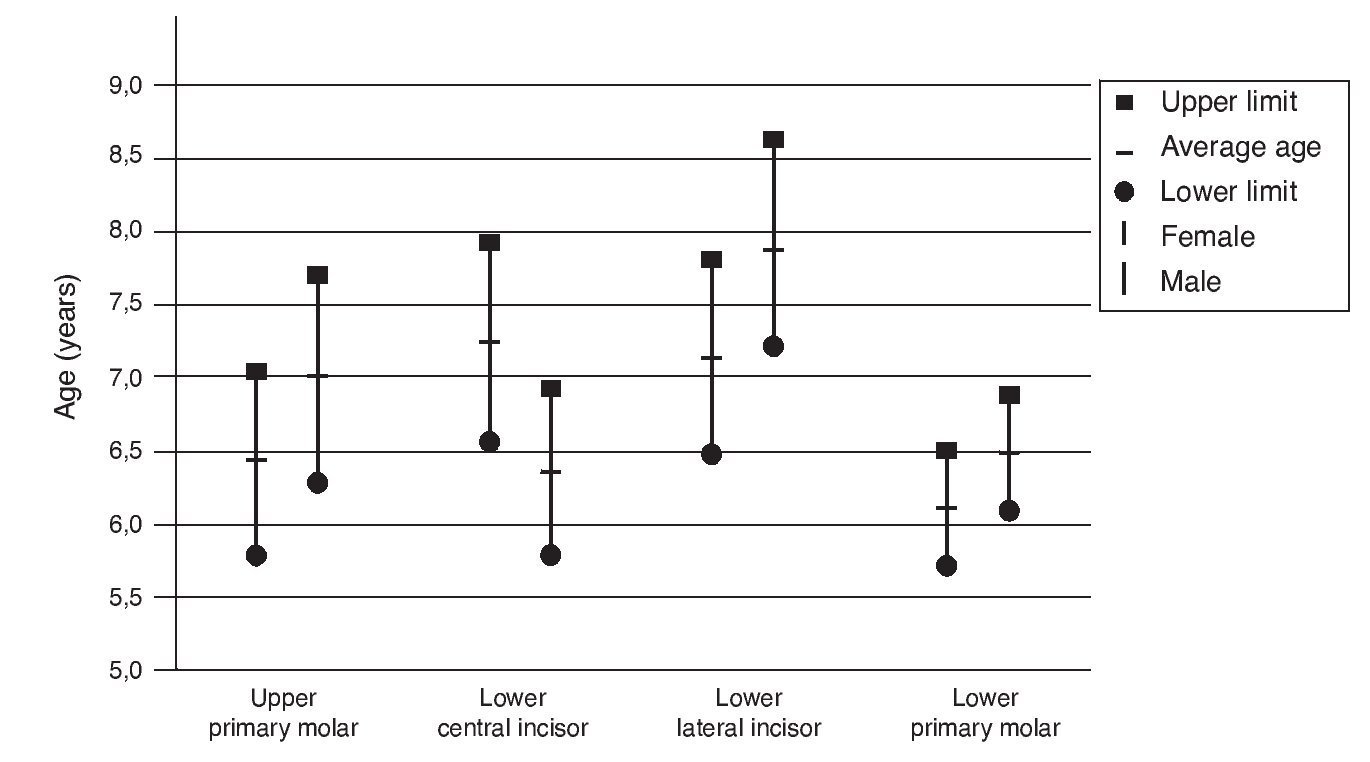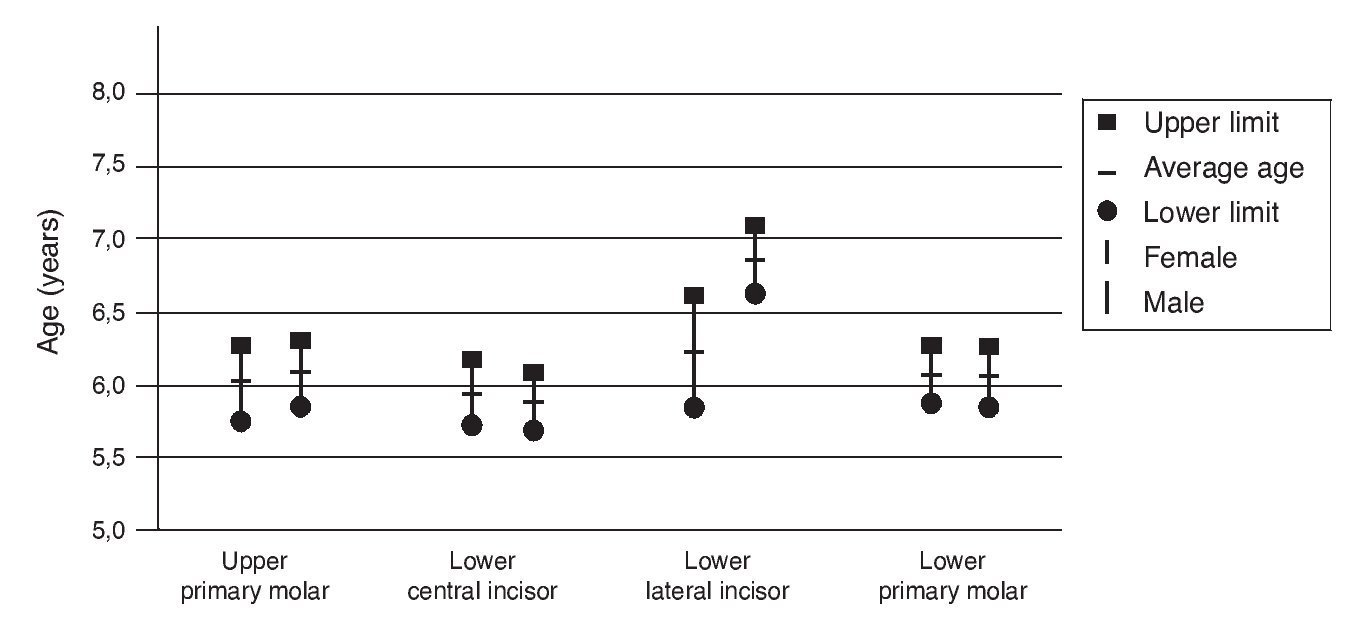Introducción: Ya que la erupción dental es el resultado de una serie de eventos fisiológicos, es importante conocer con precisión la edad promedio de exfoliación y erupción de cada órgano dentario, lo que resulta de utilidad para establecer criterios de diagnóstico, prevención y tratamiento. El objetivo de este trabajo fue comparar los métodos de estudio transversal y longitudinal en la estimación de la edad media de la erupción dental.
Métodos: Se estudió una muestra de 524 individuos (273 niñas y 251 niños) de 5-9 años de edad en el Estado de México. Se observaron los dientes permanentes presentes: primer molar superior, incisivos central y lateral, y primer molar inferior. Para el método longitudinal, se realizó el seguimiento de los niños durante 3 años, hasta registrar el brote dental. Para el método transversal, se registró la observación de los dientes presentes durante el segundo año de seguimiento. Se utilizó abatelenguas, espejo dental y luz natural.
Resultados: En ambos métodos, la erupción dental se presentó primero en el sexo femenino. La edad media de erupción dental entre los 2 métodos no mostró diferencia estadística en el 88% de los dientes.
Conclusiones: La medición de la edad de erupción dental a través del método transversal proporciona datos confiables con relación al método longitudinal.
Background: Because dental eruption is the result of a series of physiological events, it is important to acknowledge precisely the mean age of exfoliation and eruption of each dental organ. This is useful to establish diagnostic, preventive and treatment criteria. The aim of this study was to compare the cross-sectional and cohort methods toward estimating the average age of dental eruption.
Methods: The study sample was comprised of 524 school-age children from the State of Mexico (273 females and 251 males). Only permanent teeth were surveyed: the first upper molar and central and lateral incisors and the first lower molar. The cohort was observed during a 3-year period until the tooth budded. Dental mirror, tongue depressor and day light were used. Cross-sectional method consisted of permanent teeth observed after the first year.
Results: In both methods, teeth budded first in females. The average ages of dental eruption according to both methods did not show statistical difference in 88% of the teeth.
Conclusions: Measurement of the age of dental eruption through cross-sectional method provides reliable data in relation to the cohort method.
1. Introduction
Dental eruption is the result of a series of physiological events influenced by genetic and cultural factors. To have more precise knowledge of the average age of exfoliation and eruption of every tooth is useful for establishing criteria for diagnosis, prevention and treatment.1
Logan and Kronfeld,2 in 1933, published the stages of development and dental eruption, information that has been subsequently cited by authors such as Torres (1973),3 McDonald and Avery (1983),4 Ash (1986),5 Pinkham (1991),6 Duterloo (1992)7 and Bhaskar (1993)8 in order to more accurately characterize the ages of dental eruption.
Various studies have been developed to calculate the average age of dental eruption, most of them being cross-sectional, with the purpose of identifying the corresponding dental pattern of eruption. An example is the work published by Hurme9 (1949), which generated statistical tables on the chronology of dental eruption and defined standards for children from the temperate zone in the northern part of the U.S.
Establishing the age of tooth eruption using a cross-sectional method limits the results because the measurement is carried out in a heterogeneous sample at a time in which each individual is at a different eruptive phase. The pre-functional eruptive phase is constituted as a range that lasts from 3 months to 1 year 3 months, so it is not possible to observe an exact age of dental eruption.10,11
Some studies have shown that it is not possible to accurately estimate the eruption of the teeth because the influence of local factors and systemic conditions present in the social environment of each individual produce certain differences.12-15 However, the need for accurate tables of tooth eruption that helps dentists in clinical practice motivated the development of studies in which tooth development is observed from the prefunctional eruptive phase until contact is achieved with the antagonist tooth. The dynamics of tooth eruption in these studies showed an average of 4.25 years, with differences in gender and type of tooth.11,16
Longitudinal studies that have been carried out to determine the age of dental eruption are few because its development requires much time and expense. Examples of these studies are those of Savara and Steen17 and Yamaguchi and Holman18 who carried out a 20-year follow-up to identify the average age and sequence of tooth eruption in a northern European and Japanese population, respectively.
In Mexico, chronological tables of dental eruption are used, which are obtained from studies conducted in children from other countries whose ethnic, cultural and environmental characteristics are different from the various population groups that make up our country. The dental diagnosis and treatment related with the age of tooth eruption require that the clinical decisions take into consideration the specific characteristics for each region, which makes having specific information for each population group mandatory.
Based on the foregoing, it can be assumed that the age of tooth eruption obtained through cross-sectional studies is not very precise. Therefore, the purpose of this study was to compare the average age of tooth eruption calculated both longitudinally and cross-sectionally so as to identify differences between measurements.
2. Methods
The study population was comprised of 524 children (273 females and 251 males) with ages from 5 years 0 months to 9 years 0 months, enrolled in the third grade at the pre-school level and from first to third grade at the primary school level in the neighborhoods of Ciudad Nezahualcóyotl and Chimalhuacán, State of Mexico. A sample was obtained for convenience and the size was calculated based on the longitudinal study, integrating children from 5 to 6 years of age in an interval that would comprise all the possible ages of teeth eruption to examine during a 3-year span. Excluded from the sample were those students whose parents did not consent for their children to take part in the study, those with palate malformation and those who had dental orthotics. Those children who were not seen for two consecutive sessions were eliminated from the study.
Longitudinal and cross-sectional methods were applied to identify the median age of permanent tooth eruption: first molar and central incisor of the maxilla and lateral incisor and first molar of the mandible. For the longitudinal method a monthly review was carried out for 3 years in those individuals who did not have the specific tooth to observe, and the age of the child was recorded at the time of the tooth eruption of the four types of teeth. For the cross-sectional method, only one examination was done, in only one stage, at the middle of the school cycle of the second year of follow-up in the same sample cohort. The criteria for choosing this time for measurement in the cross-sectional method was to give an opportunity for the tooth eruption in children who at the beginning of the study did not have any permanent teeth.
An intra- and interobserver standardization process was carried out, which yielded a kappa coefficient of 0.95 and 0.89, respectively. Two observers performed the oral examination with a visual inspection using a wooden tongue depressor, a dental mirror and natural light using the standardized criteria of recording the tooth present when at least one of the cusps or incisor border of the crown of the tooth has come through the gingival epithelium.1,3,5,9,10 The data for each student (name, date of birth, gender, group, school and date of mouth examination) were recorded in an epidemiological file. The parent or guardian signed informed consent.
Student t test was applied with a 95% CI to compare the average ages of the tooth eruption of each type of tooth in the female group with relationship to the male group in each of the study methods and to compare the average ages of the female and male groups between the cross-sectional and longitudinal methods. Student t test was used to analyze if there were differences in the average ages of eruption between the teeth from the left and right sides. SPSS v.10.0 was used for statistical analyses.
3. Results
Because there were no differences between the right and left side for the average ages of tooth eruption observed, a total of eight types of teeth were classified, four for females and four for males. Presentation of the results began with the description for the cross-sectional method and subsequently with the longitudinal method. Finally, a comparison was made between both methods where a greater homogeneity in the data obtained with the longitudinal method was able to be seen.
3.1. Cross-sectional method
The average age of tooth eruption was obtained through the cross-sectional method. It was observed that it is earlier in the female group in three of the four types of teeth studied, with the exception of the lower central incisor ( Table 1). The differences were from 5 months for the lower first molar to 10 months for the lower central incisor. In this group, the tooth that erupted first was the lower first molar (6 years 1 month) and the last was the lower central incisor. In males, tooth eruption began with the lower central incisor (6 years 4 months) and ended with the lower lateral incisor (7 years 2 months). Student t test was applied to compare the average ages of tooth eruption between groups and statistically significant differences were seen in three types of teeth (p<0.001).
Figure 1 shows the ranges of permanent teeth eruption. The ranges were calculated adding and subtracting the average one time from the standard deviation. These estimates were done with a probability of error <0.05 (p<0.05). The ranges varied from 10 months for the first lower molar to 1 year 5 months for the lower lateral incisor, taking into consideration from the first child to the last child in whom the same tooth erupted. The amplitude of the ranges of tooth eruption was similar in both genders except for the lower lateral incisor, which was higher by 4 months in females.
Figure 1 Median age and ranges of tooth eruption by gender and type of tooth analyzed cross-sectionally.
3.2. Longitudinal method
The average age of tooth eruption was obtained through the longitudinal method (Table 2). Similar values were obtained between genders with the exception of the lower lateral incisor whose eruption was earlier in females (6 years 3 months) compared with the male group where it erupted 7 months later (6 years 10 months). The difference was statistically significant (p<0.001) according to the Student t test. Tooth eruption reported with this method began with the lower central incisor in both groups at the age of 5 years 11 months and ended with the lower lateral incisor at 6 years 10 months in males.
Figure 2 shows the ranges of permanent tooth eruption. The amplitude of the ranges is similar in both genders except for the lower lateral incisor which, in females, has a range of 9 months and in males, 6 months, with a difference of 3 months. The first lower molar was the tooth that had the shortest range (4 months) and the lateral lower incisor had the longest range for females (9 months).
Figure 2 Median age and ranges of tooth eruption by gender and type of tooth analyzed longitudinally.
3.3. Comparison of methods
Comparison of the average age of eruption of the eight types of teeth observed between the cross-sectional and longitudinal methods was carried out with the Student t test. Table 3 shows no statistically significant differences in 88% of the teeth compared. Only in females was a significant difference seen in the lower central incisor where the longitudinal method reported a tooth eruption of 1 year 4 months earlier than the cross-sectional method. For males, the comparison of the average age of eruption between methods did not show any statistically significant difference in any of the teeth studied. However, data obtained with the longitudinal method were more homogeneous. This was able to be seen in the standard deviation of the averages, which showed variability of 3 to 4 months for the longitudinal method and 5 to 8 months for the cross-sectional method. Age ranges of tooth eruption obtained with the cross-sectional method were greater, up to 1 year 2 months for the lower lateral incisor compared with the longitudinal method, whose range of greater amplitude was 8 months for the same tooth.
4. Discussion
In general, for the two study methods, an earlier age of tooth eruption was observed in females compared to males, which coincides with the reports by Kutesa et al.19 in Uganda, Hurme9 in a North American population, Romo et al.20 in México, Mora et al.13 and Morgado-Serafín and García-Herrera15 in Cuba, Plasencia et al.21 in Spain and Virtanen et al.22 in Finland.
Results obtained using the cross-sectional method showed that there were statistically significant differences between genders for three types of teeth. In some prior studies performed in a population of Ciudad Netzahualcoyotl, State of Mexico, earlier tooth eruption was noted in females.12,20,23
Although there is no conclusive evidence that explains this sexual dimorphism, it should be mentioned that it has been attributed to the so-called growth peaks first occurring in females and the hormone effect on dental development.14,21
Some similarities were observed in females in foreign studies such as the average age of the eruption of the upper first molar, which was 6 years 5 months, similar to what was reported by Savara and Steen17 in a U.S. childhood population, the lower first molar with an average age of eruption of 6 years 1 month as reported by Eskeli et al.24 in Finland and Plasencia et al.21 in Spain, the upper lateral incisor with an average age of 7 years 1 month, the same as reported by Parner et al.25 in Denmark.
With regard to the male gender, similarities with the literature were with the first lower molar with an average age of eruption of 6 years 5 months, as studied by Savara and Steen17 and the lower lateral incisor with an average age of 7 years 1 month, similar to what was reported by San Miguel-Pentón et al.26 in Cuba. The average age of eruption of the lower central incisor, from 6 years 3 months, coincides with what was reported Plasencia et al.21 in Spain.
The average ages of tooth eruption obtained using the cross-sectional method were lower compared to what was previously observed in a Mexican population. In the neighborhoods of Aurora and Benito Juarez in Ciudad Netzahualcoyotl, State of Mexico, it was observed that in general the average ages of tooth eruption were greater than in the present study except for the lower central incisor in females and lower lateral incisor in males, with a difference of 7 months.20
The results obtained through the longitudinal method showed statistical significance between genders only in the average age of eruption of the lower lateral incisor. Slight differences were observed, from 1 to 5 months, compared with what was published by Savara and Steen,17 except in the average age of eruption of the lower central incisor of females, which was 1 year lower in the present study.
For the eight different teeth studied (four for females and four for males), the average ages of tooth eruption obtained with the longitudinal observational method were a slightly earlier in relation to the average ages obtained with the cross-sectional method. There were no statistically significant differences observed in 88% of the total teeth studied, only a statistically significant difference for the lower central incisor for females. Age of eruption of the first inferior molar in females was recorded at 6 years 1 month with both methods of measurement.
Given the accuracy of the observations with the cross-sectional method, it was expected that the ranges obtained would be greater than those with the longitudinal method. This was confirmed because the extent of the ranges obtained by the cross-sectional method was up to 1 year 2 months in comparison with the longitudinal method, whose extent was 8 months.
The comparison between methods of measuring the ages of tooth eruption offers an important contribution to this line of research whose purpose is to study the profiles of tooth eruption in the Mexican population. It was observed that, with the longitudinal method, high precision in the measurements is obtained because one can more clearly observe the tooth bud, whereas with the cross-sectional method this is not so because during the observation, tooth eruption is measured at some point in the prefunctional eruptive phase.
The results of this study confirmed that although the longitudinal method is more accurate than the cross-sectional method, it requires a long period of observation and is expensive. The results showed sufficient evidence to establish that the profiles of the average age of tooth eruption obtained with the cross-sectional observation method are as reliable as those obtained with the longitudinal method.
Taking into consideration the likely influence of local factors in the social environment, it is considered convenient to give continuity to the line of research with the intention of expanding the sample and verifying the relevance of developing tables of the average age of tooth eruption for the Mexican population in general or, if it is of greater benefit, to develop tables according to region or to the local level.
Conflict of interest
The authors declare no conflict of interest of any nature.
Received 13 June 2014;
accepted 4 December 2014
☆ Please cite this article as: Valdez Penagos RG, Sánchez Acuña G, Romo Pinales MR, Miranda Campos A, Tovar Rodríguez AA, Yánez Valdivia D. Edad media de la erupción dental en una población escolar analizada por dos métodos. Bol Med Hosp Infant Mex. 2014;71:352-357
* Corresponding author.
E-mail:romorp@servidor.unam.mx (M.R. Romo Pinales).













